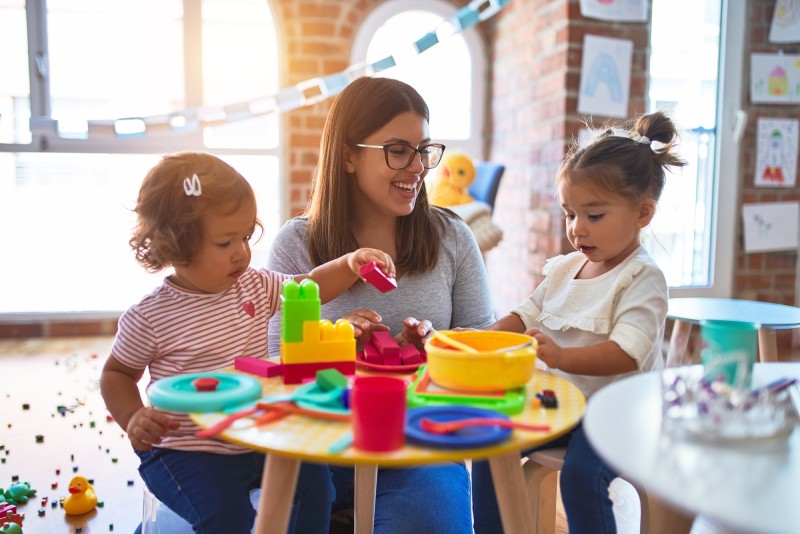Business
Toddler Education: Nurturing Curiosity In The Early Years

Imagine your toddler taking their first steps or saying their first word. These milestones are monumental, but they’re just the beginning. The early years are crucial for your child’s development, and education plays a big role in it.
This article aims to be your guide for nurturing curiosity in toddlers. We’ll explore how to recognize signs of curiosity, foster a safe environment, encourage exploration, and much more. Read on to unlock the boundless potential of your child’s early years.
Recognizing Curiosity In Toddlers
Curiosity in toddlers isn’t hard to spot if you know what to look for. These young minds are like sponges, eager to absorb the world around them. Recognizing these signs early can make a big difference. Let’s delve into the behavioral indicators and why they matter.
One of the clearest signs is the toddler’s interest in exploring their surroundings. You’ll find them crawling toward new objects, turning them over, or even putting them in their mouths. Places like the Brookvale Childcare Centre provide environments that are tailored to stimulate this kind of curiosity.
Another unmistakable indicator is the barrage of questions. ‘Why is the sky blue?’ ‘What’s this?’ ‘How does that work?’ These questions may seem endless, but they’re a good thing. It shows your child is keen on understanding the world.
Recognizing these signs is crucial. It’s the first step in guiding your child’s inquisitive nature in a positive direction. It helps you create experiences that foster learning and development.

Fostering A Safe Environment
Safety and curiosity should go hand-in-hand in a child’s world. To ensure that your toddler can explore without risks, consider these specific steps:
- Evaluate Common Spaces: Identify areas your toddler frequently visits. Look for potential hazards like table corners and electrical outlets.
- Corner And Outlet Safety: Install cushioned corner protectors and electrical outlet covers. These are simple yet effective ways to make common areas safer.
- Childproof Cabinets: Toddlers love to explore drawers and cabinets. Use safety latches to keep household cleaners and medicines out of reach.
- Flooring Considerations: In play areas, opt for soft flooring. Choices like foam tiles or plush rugs minimize the risk of injury during falls.
- Supervision: While freedom is key, some form of oversight is crucial. Use baby monitors with cameras to keep an eye on your toddler’s activities.
- Verbal Cues: Introduce simple commands like ‘stop’ or ‘be careful.’ Repeating these cues can instill a natural sense of caution in your child.
By implementing these tips, you create a nurturing environment. Here, curiosity can flourish, and your toddler can explore with fewer risks involved.
Encourage Exploration
Fostering a sense of discovery in your child requires more than just a safe environment. Active engagement in diverse activities propels learning and feeds curiosity. Here’s how you can go beyond the basics to encourage genuine exploration:
- Themed Treasure Hunts: Create a treasure hunt around the house or yard with a specific theme. It could be ‘colors’ one day and ‘shapes’ another, offering a fun, educational quest.
- Simple DIY Experiments: Introduce the excitement of science with straightforward experiments. For instance, a baking soda and vinegar volcano not only thrills but also introduces basic chemistry concepts.
- Nature Walks With A Twist: Venture outdoors but make it educational. Equip your child with a magnifying glass and a checklist of items to spot. This makes a regular walk more interactive and educational.
- Interactive Storytelling: Engage in storytelling sessions where your child can choose the path of the story. It encourages creative thinking and keeps them invested in the narrative.
- Parental Participation: While independent play is essential, your involvement amplifies the learning. Co-read books, co-create art, and ask guiding questions to deepen their understanding.
- Timed Challenges: Introduce games or activities that are time-bound. It not only makes tasks exciting but also aids in developing a sense of time and accomplishment.
Through these methods, you not only spark your toddler’s curiosity but also actively participate in shaping their understanding of the world. Actively exploring together creates richer experiences and more meaningful memories.
Using Questions To Fuel Curiosity
Questions serve as the catalysts for inquisitive minds. They open doors to new knowledge and perspectives. In this section, we’ll explore diverse strategies to invigorate your child’s curiosity through the art of questioning.
- Prompting Curiosity: Spark your child’s inquisitiveness by creating curiosity-invoking scenarios. Show them a half-opened box and encourage them to discover what’s inside, provoking them to ask questions naturally.
- Question Jar: Create a jar filled with intriguing queries like ‘What makes rain?’ or ‘Why do dogs bark?’ Pull out a question during quiet times and explore the answers together.
- Parental Inquiry: As a parent, your role isn’t just to answer questions but to ask them as well. Open-ended questions like ‘What do you think happens next?’ or ‘How do you feel about that?’ invite elaboration and reasoning.
- Embrace ‘I Don’t Know’: Teach your child that it’s acceptable not to have all the answers. It creates an opportunity for mutual discovery and lifelong learning.
- Reverse Roles: Allow your toddler to become the ‘questioner’ during storytime or activities. It lets them explore from a different perspective and enhances their confidence in leading conversations.
By embracing and cultivating a culture of questioning, you’re not just entertaining fleeting curiosity. You’re nurturing a lifelong learner who is unafraid to seek answers and venture into the unknown.
Conclusion
Nurturing curiosity in your toddler is an investment in their future. It builds the groundwork for a lifetime of learning and discovery. Creating a safe environment, encouraging exploration, and asking the right questions are just a few ways to fuel this natural instinct.
So, what’s the next step? It’s time for action. Start simple. Maybe plan a nature walk this weekend or begin a small DIY project with your child. Your child’s innate curiosity is a gift; let’s not waste it. Let’s cultivate it together for a richer, more rewarding journey through life.
-

 Sports4 weeks ago
Sports4 weeks agoAl Ahly vs Inter Miami, 2025 FIFA Club World Cup – Preview, Prediction, Predicted Lineups and How to Watch
-
Health3 weeks ago
Back to Roots: Ayurveda Offers Natural Cure for Common Hair Woes
-

 Tech3 weeks ago
Tech3 weeks agoFrom Soil to Silicon: The Rise of Agriculture AI and Drone Innovations in 2025
-

 Startup4 weeks ago
Startup4 weeks agoHow Instagram Is Driving Global Social Media Marketing Trends
-

 Sports3 weeks ago
Sports3 weeks agoFIBA 3×3 World Cup 2025: Full Schedule, Preview, and How to Watch
-

 Science4 days ago
Science4 days agoJuly Full Moon 2025: Everything You Should Need to Know, When and Where to See Buck Moon
-

 Gadget3 weeks ago
Gadget3 weeks agoThings to Know about Samsung Galaxy S26: What’s New and What’s Next
-

 Sports4 weeks ago
Sports4 weeks agoWorld Judo Championships 2025: Full Schedule, Date, Time, Key Athletes and How to Watch













